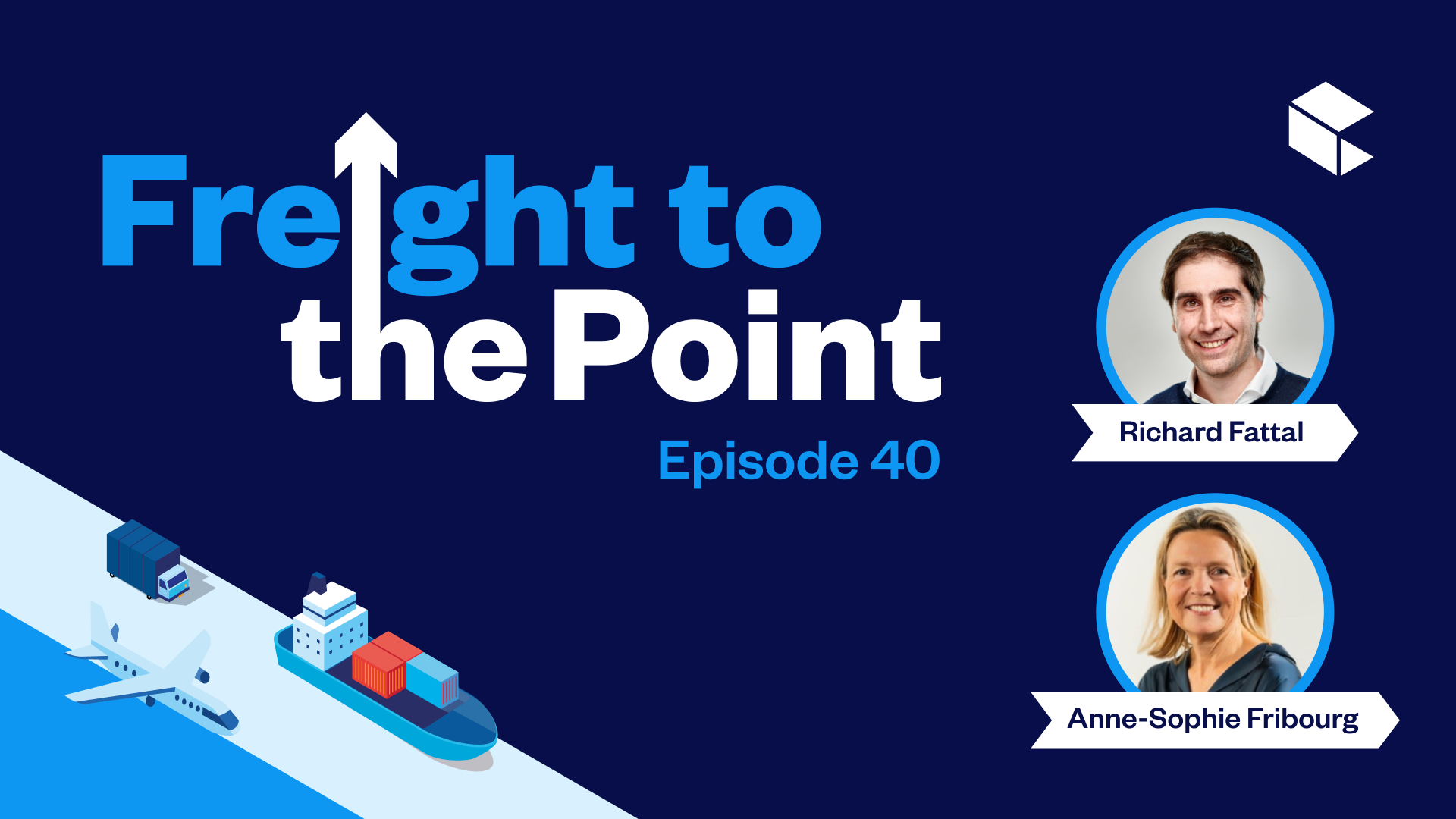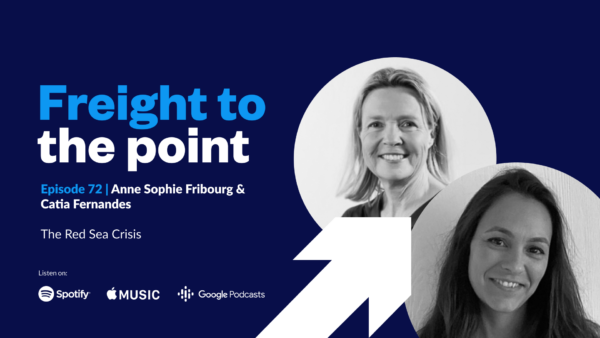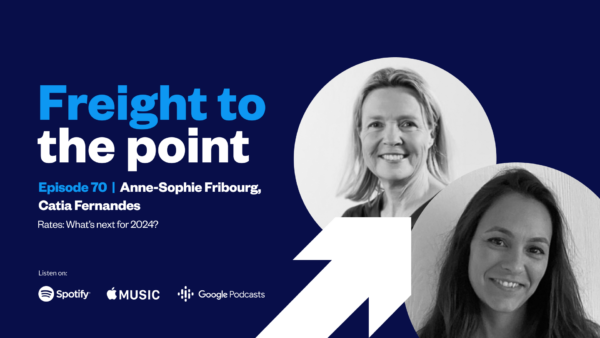Episode 40:
Zencargo's February Ocean Update
See all episodes

Tune into the latest episode of Freight to the Point as we’re giving you another monthly ocean update from the Zencargo team.
Richard Fattal, CCO and Co-Founder at Zencargo and Anne-Sophie Fribourg, VP of Ocean Procurement sat together to talk through some of their latest insights for February.
Together, they explore:
- How the IMO regulations affects shippers and carriers
- The recent announcement of the 2M alliance split
- Whether it is a good time for shippers to tender
Anne-Sophie Fribourg
Anne-Sophie has over 20 years of experience in the freight forwarding industry, having worked in Singapore, the Middle East region and France for a French freight forwarder. At Zencargo, Anne-Sophie leads the ocean team to obtain the best rates and space, building supply chain resilience for our customers.
Richard Fattal
Richard Fattal is Co-Founder and Chief Commercial Officer of Zencargo, the digital freight forwarder enabling organisations to make smarter decisions through real-time data of their supply chain. Based in London, Zencargo helps customers such as Swoon Furniture and Ribble Cycles, manage their supply chains.
Resources
Ocean Deep Dive: 5 Things You Need To Understand This January
Anne-Sophie Fribourg:
Hi, and welcome to another episode of Freight to the Point. I’m Anne-Sophie Fribourg, Zencargo’s VP of Ocean Procurement. Today we’ve invited Richard Fattal back on again to talk about what’s happened in the ocean market in the past months and what we need to look out for in the months of February. Richard works very closely with customers at Zencargo to get the best rates and transit times, as well as providing bespoke rate consultations.
Welcome, Richard.
Richard Fattal:
Hi Anne-Sophie. Thanks so much for having me on.
Anne-Sophie Fribourg:
In the last ocean episode, we talked about the impacts of an early Chinese New Year on shippers, such as the early closure of factories, the effects on rates and capacities through Chinese New Year, and the reversal of China’s lockdown policies. So many things have happened in the last months. We’ve just had an early Chinese New Year, as mentioned before, and IMO 2023 has also started from January this year.
Richard, have we seen an impact so far this year from the IMO regulation?
Richard Fattal:
I think the short answer is no, we’ve not seen an impact yet. And I would say that the impact looks to be limited, for the time being at least. And if you don’t know anything about the IMO 2023, it’s now effective from the start of the year. And the aim of the regulations, it’s an international regulation which is aimed at reducing emissions from shipping by 40% by 2030, and 70% by 2050. And it is benchmarked off of 2008 levels.
In particular, what it does is. It introduces mandatory regulations on carbon emissions for both new and existing ships, and it leverages some energy efficiency indicators to basically set the level of carbon emissions from those vessels. And older tonnage really struggles to comply with the regulations, so older vessels. These vessels need to be retrofitted in order to get up to scratch. Whereas newer vessels, particularly those running dual fuel, and LNG, as well as the new methanol vessels, are more compliant.
Anne-Sophie Fribourg:
What does it mean in terms of capacity, Richard?
Richard Fattal:
That’s the interesting point. You start to think about, what does it actually mean? Some vessels need to get taken off of the market, so they need to effectively go into docks and be retrofitted, which takes a period of time to have new adjustments and changes made to the ship in order to ensure that they’re compliant.
Anne-Sophie Fribourg:
That might absorb some capacity, right?
Richard Fattal:
Yes. And the other way in which capacity gets absorbed is that you can slow down vessels, and by slowing down vessels you reduce the carbon emissions.
Anne-Sophie Fribourg:
But you need to add one more ship to the loop, I guess, if you slow down vessels?
Richard Fattal:
Exactly. A lot of commentators have been trying to calculate, what is the real effect of impact of IMO regulations. From speaking to shipping lines and understanding their strategies, what we’ve understood is, as an example, if you take Asia, Europe, slowing down the vessels, effectively means a 12-week turn of the vessels from Asia into Europe around the various ports and then back out to Asia, becomes 13 weeks. That increase from 12 weeks to 13 weeks is equivalent to a 7% reduction in capacity.
With that said, the question becomes, is that going to really have an impact on the market? What we know is that, there’s at least a 10% increase in capacity that’s coming into the market this year. With that, combined with the increase in effective capacity because of the reduction in port congestion that we’ve spoken about a number of times before and the reduction in the demand, we don’t really see the IMO having an impact on the balance between supply and demand.
Anne-Sophie Fribourg:
That could have more impact next year with the amount of capacity coming in?
Richard Fattal:
Later in the year, I think it could start to have an impact. And then there’s a question of what the impact is next year. It’s also interesting to bear in mind the relative impact, because it will have a relatively different impact to different carriers who have a different fleet. It’s going to be exciting to watch this space on the IMO. But I would say for now, it’s not something that I would be overly concerned with.
Anne-Sophie Fribourg:
Another subject then, in recent news we’ve heard that the 2M alliance, MSC and Maersk, have announced a split. It is expected that the alliance will remain until January, 2025. How do you think this will impact the shippers and the other carriers?
Richard Fattal:
For those who don’t know, the 2M alliance is an alliance between the two largest carriers in the world, Maersk and MSC. They effectively were working together and will continue to do so until the end of the alliance on sharing vessel capacity, so that they can offer slots on each other’s vessels in order to be able to offer a higher frequency of services from the various ports that they move to and from around the world. It does yield more convenience to the customer.
The reality is that I think there’s going to be a very interesting and different effect for each of Maersk and MSC, really, based on their differing strategies. MSC’s clear strategy through the COVID period has been to grow its fleet. And it’s had one of the biggest growths in fleet acquisition and also in new builds over the full COVID period. And their feet is set to increase in size substantially over the next couple of years.
Maersk, in the meantime, have not been investing in the same way in their capacity. Instead they’ve been quite focused on building out their logistics and supply chain capabilities, and that will have an impact on their strategies going forward. And I think it’s probably more likely that Maersk looks for a new combination of partners that they would slot share on, in order to be able to offer a broader regularity of service. Whereas, MSC are more likely to be in a position with the new builds that they have coming on to perhaps go into some slot sharing agreements on key lanes, but perhaps not engage in a more broad slot sharing carrier agreement.
What I think that means is that, there can really be ripple effects across the rest of the alliances and broader impact for the market.
Anne-Sophie Fribourg:
That might reshape the landscape. Or do you think that it’ll reshape the frequency of sailings because, as you said, it might have some effect on the other alliances, on the other shipping lines?
Richard Fattal:
I think it allows all the shipping lines to look at their network, to look at the efficiency of the way in which they’re working, to look at their port relationships and port agreements, whether they own ports or they have contractual relationships with different ports, and to see what suits them best and what suits their customer base the best. And that could, as you say, have real impacts in terms of new alliances being formed or changes in the alliances. And what that means for shippers is, it might mean that there are new services that pop up that might be very convenient for them.
Anne-Sophie Fribourg:
More options for customers.
Richard Fattal:
It might, but it also might mean a reduction in the frequency of sailings. Because today on the Asia Europe as an example, on all of the alliances, you have pretty much a daily departure. Of course, there are blank sailings in the market at the moment that reduce that, but there’s a lot of choice. And what it might do is, it might restrict some of that frequency, although it might open up new opportunities for new routes.
Anne-Sophie Fribourg:
Exactly. And we’ve seen recently that Hapag-Lloyd has just signed a slot agreement with CMA, so that has cut their own service. And they are now on the CMA vessel, so on another service, so we might see more of this in the coming months probably.
Richard Fattal:
100%. And I think it means that customers, at the end of the day, have to be a little bit agile in terms of the way they approach how they’re contracting, and they have to approach things with an open mind.
Anne-Sophie Fribourg:
That’s really interesting, Richard.
In other news, we’ve seen also that over 50 sailings have been removed in the first seven weeks of 2023, mainly on the East-West route. Given that so many blank sailings have been removed this year already, how far do you think carriers will go?
Richard Fattal:
I think the carriers do have one eye on service and they think about, how do I reduce capacity in order to meet effective demand but still offer some level of service to my customers. But I think on the TP and on the Asia Europe, there’s a lot of capacity and there’s a high level of frequency, so carriers are able to take out services and still provide regularly multiple services per week on key routes. As such, they felt quite comfortable taking out capacity and, at the same time, not dramatically disrupting service to customers. Particularly, given customers have been experiencing very elongated lead times for the last few years. All they’re effectively doing is reversing some of the improvements that we’ve seen in the market by taking out this capacity.
I think what’s quite interesting is that for the moment, the capacity reductions have not stemmed the decline in rates. We continue to see softness both on the Asia Europe, and the Trans-Pacific markets, and now rippling into some of the other markets that had been stronger, like the Trans-Atlantic. I would say that I would see them continuing to take out some capacity.
But on the other hand, we do see, at least from our customer base, an indication that customer inventory levels are now much closer to normal levels. And whilst it takes quite a bit of time to work through a destocking environment to then go back into the mode of placing orders, have goods become ready, and cargo ready to move, that cycle is starting to take hold.
We would anticipate the effect of this reduction in capacity starting to have some impact on the market over the coming weeks and months as we start to see customers change their behavior.
Anne-Sophie Fribourg:
You are saying that, on one side, due to capacity reduction, we see that rates are also dropping. Are you saying that it’s a good time for businesses to go through tenders, to start the processes of tenders?
Richard Fattal:
I do think so. I think in any market you always see overshooting and undershooting. When a market gets into an imbalance, demand is greater than supply, supply is greater than demand. You can really see big swings. And I think we’re seeing that now in the freight market.
But I do think there’s an opportunity to think about stability, stability of both service and rate, and to think about a diversified strategy, bearing in mind that there can be some disruptions to service in an environment where carriers are blanking, so you may need some diversification in your approach. But I do think it’s a time to engage with your freight partner and to discuss opportunities to lock in longer validity, to look at renewing rates.
Anne-Sophie Fribourg:
Especially because when you are engaged, you can get space commitment also from the partners.
Richard Fattal:
That’s what I would say. I think now it’s a time to start thinking about those space commitments from partners, because the market has really loosened up. But it can certainly tighten again once the businesses really start to move into a restocking trend.
Anne-Sophie Fribourg:
Very well. Diversify rate strategy could be a real benefit, considering the present situation we are facing now?
Richard Fattal:
100%. I’ve said before, a diversified rate strategy is all about understanding the flow of goods, those goods that are super urgent and regular, those goods that you might have higher stock levels of and can afford to move a little bit more slowly or not move at all. And thinking about a rate strategy for the base load, for the goods that move even volume on a monthly basis with limited seasonality.
And then separately, how are you going to manage spikes? And that very much depends on what your seasonality looks like as a customer and how that compares to the profile of the market. I would definitely encourage you to engage in a conversation with your partner because you can really start to understand what’s the appropriate market strategy for my business effectively.
Anne-Sophie Fribourg:
And visibility. We all know that it is key for carriers to be able to forecast and to plan their strategy over the coming months.
Thank you very much, Richard. That was very interesting. Thank you again to our listeners for tuning into this episode of Freight to the Point. Don’t forget to like and subscribe to our show, and if you have any feedback on this episode, please do not hesitate to reach out on LinkedIn.
But until our next episode, goodbye.

Episode 72: The Red Sea Crisis
In the latest episode of Freight to the Point, we’ve featured our most rec...

Episode 71: The potential of demand forecasting with artificial intelligence
In the most recent instalment of Freight to the Point, Lucie Phillips, Zen...

Episode 70: Rates: What's next for 2024?
As we prepare for the year ahead, it's crucial to consider the three pillars...

